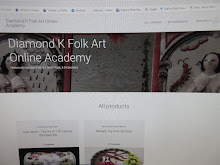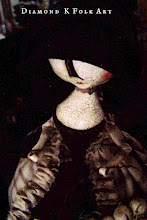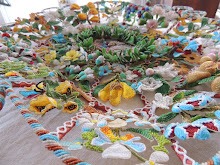Thursday, June 28, 2012
Sunday, June 24, 2012
Tuesday, June 19, 2012
So Commonly Rare...
Trevette asked me a while ago if I would share some of the early mitts here at the Museum on the blog, so I chose a few this morning, of my most prized and rare examples for your pleasure. You will find no fancy silk mitts here today, no colorful embroidery...no initials or love sentiments...just wonderful early linen mitts and gloves the ladies, both young and olde, wore everyday. This first pair are for a young lady, and as you can see, have points that fold back over the back of the hand. From the fold, to the back edge, they measure 11" long....which actually, is the measure of the back of my own hand to my elbow....so why do I think these are for a young girl you ask? The wrist is a scant 4& half inches in circumference. There is no opening at the palm of the hand or inner wrist like on late 19th c gloves, so one's hand must be small enough to fit thru the narrowest part of the mitt's sleeve.
The tip of the thumb is open, and there are 3 lines of decorative stitching at the back of the hand, ending at the foldover seam. These early gloves were stitched from fabric cut on the bias so they would be more flexible and fit to the arm better. In the 18th c it was common & fashionable to have the points that folded back over the hand. One could protect their skin from the sun, and yet still have their fingers free to do needlework, hold a tea cup ect.
Please do click on the pictures to enlarge them~ the stitching is amazingly tiny, its very hard to see individual stitches with the nekkid eye!
The thumb is set in deep, and is cut in a curve to follow the thumbs natural position and not have bulky wrinkles. Note the darn center front here~ one reason everyday linen gloves are so very, very rare to find, in single or in pair, is that they were indeed worn every day, and were subject to alot of stress...literally worn to bits. In fact, the match to this one I have not padded, as the palm has worn so very thin it is transparent.
There is a join in the fabric that runs from the "i" in Repository up to the tip of the inner thumb~ one of 7 such joins on this mitt
Here you can see the triangular flap folded over. These were worn by Mary Wistar, born 27 Nov. 1765 in Philadelphia. Due to the size, she most likely wore them around 1775-80. She was not a small woman, as these were obtained with many other items of her wardrobe, so I could be stretching the date a little.
This cunning pair of fingerless mitts are for a small child, and measure a scant 9" from end to end. They are made of extremely fine linen, with drawstrings around the arm edge.
Cut to fit straight across the back of the hand at the knuckles, and without fitted thumbs, just finished openings, both of which have stress related tears at the outside thumb edge.
Here you can see the size comparison ~ the fold over mitts are to the far right in the above photo, the childs across the top. The single mitt to the far left, and the pair of gloves in the center, were worn by Mary B. Decon in 1794.
The single mitt is of paper thin cambric~ you can see the thumb placement is similar to Mary Wistar's mitts, with the thumb ending even with the front hem~ this would cover the thumb up to the knuckle.
The stitching on the back of the hand
There is no rule that all mitts need have points, or a certain date range for one having or not having them, it was personal preference.....and depended if the wearer followed the fashion trends or not. These too are cut on the bias, as they all are, but they have a simple fold over cuff with no drawstring at the elbow end.
The gloves are my favorite, for too many reasons to list. They are very fragile and have several places in the fingers where the cambric has worn to beyond paper thin....but they also have darn after darn....both top thumb seams have been stitched over a few times...perhaps Mary had long nails that wore them out? Here you can see the stitching at the back of the hand, along with those awesome finger gussets!
This engraving is from 1766, note the young woman's fold back mitts....tres fashionable!
In this plate from 1784 you can clearly see the fitted thumb and open fingers of her green silk mitts as she delicately wields her scissors in one hand, and lace in the other.
Trevette asked me a while ago if I would share some of the early mitts here at the Museum on the blog, so I chose a few this morning, of my most prized and rare examples for your pleasure. You will find no fancy silk mitts here today, no colorful embroidery...no initials or love sentiments...just wonderful early linen mitts and gloves the ladies, both young and olde, wore everyday. This first pair are for a young lady, and as you can see, have points that fold back over the back of the hand. From the fold, to the back edge, they measure 11" long....which actually, is the measure of the back of my own hand to my elbow....so why do I think these are for a young girl you ask? The wrist is a scant 4& half inches in circumference. There is no opening at the palm of the hand or inner wrist like on late 19th c gloves, so one's hand must be small enough to fit thru the narrowest part of the mitt's sleeve.
The tip of the thumb is open, and there are 3 lines of decorative stitching at the back of the hand, ending at the foldover seam. These early gloves were stitched from fabric cut on the bias so they would be more flexible and fit to the arm better. In the 18th c it was common & fashionable to have the points that folded back over the hand. One could protect their skin from the sun, and yet still have their fingers free to do needlework, hold a tea cup ect.
Please do click on the pictures to enlarge them~ the stitching is amazingly tiny, its very hard to see individual stitches with the nekkid eye!
The thumb is set in deep, and is cut in a curve to follow the thumbs natural position and not have bulky wrinkles. Note the darn center front here~ one reason everyday linen gloves are so very, very rare to find, in single or in pair, is that they were indeed worn every day, and were subject to alot of stress...literally worn to bits. In fact, the match to this one I have not padded, as the palm has worn so very thin it is transparent.
There is a join in the fabric that runs from the "i" in Repository up to the tip of the inner thumb~ one of 7 such joins on this mitt
Here you can see the triangular flap folded over. These were worn by Mary Wistar, born 27 Nov. 1765 in Philadelphia. Due to the size, she most likely wore them around 1775-80. She was not a small woman, as these were obtained with many other items of her wardrobe, so I could be stretching the date a little.
This cunning pair of fingerless mitts are for a small child, and measure a scant 9" from end to end. They are made of extremely fine linen, with drawstrings around the arm edge.
Cut to fit straight across the back of the hand at the knuckles, and without fitted thumbs, just finished openings, both of which have stress related tears at the outside thumb edge.
Here you can see the size comparison ~ the fold over mitts are to the far right in the above photo, the childs across the top. The single mitt to the far left, and the pair of gloves in the center, were worn by Mary B. Decon in 1794.
The single mitt is of paper thin cambric~ you can see the thumb placement is similar to Mary Wistar's mitts, with the thumb ending even with the front hem~ this would cover the thumb up to the knuckle.
The stitching on the back of the hand
There is no rule that all mitts need have points, or a certain date range for one having or not having them, it was personal preference.....and depended if the wearer followed the fashion trends or not. These too are cut on the bias, as they all are, but they have a simple fold over cuff with no drawstring at the elbow end.
The gloves are my favorite, for too many reasons to list. They are very fragile and have several places in the fingers where the cambric has worn to beyond paper thin....but they also have darn after darn....both top thumb seams have been stitched over a few times...perhaps Mary had long nails that wore them out? Here you can see the stitching at the back of the hand, along with those awesome finger gussets!
The drawstring at elbow hem to keep them up on the arm~
In this fashion plate from 1803 you can see the gloves tie well above the elbow. (dont forget to click on it to make it larger)
In this plate from 1784 you can clearly see the fitted thumb and open fingers of her green silk mitts as she delicately wields her scissors in one hand, and lace in the other.
Friday, June 08, 2012
Tuesday, June 05, 2012
Girl's Bottle Green Silk dress, 1841
This little tag was gently still attached to one of the eyes at the back closing. Before I get into what it has told me....let me just thank the generations of hands that this dress has gone through, both related and not, for not removing it. I hope that if you, dear readers, purchase things to keep or sell, with little notes attached, no matter how cryptic they may seem, keep them with the piece! This gown is a wonderful piece of history without known provenance, but with it, History comes more alive, more easy for our minds to grasp, when we can match it with a name, and therefore a physical place in time and history.
From clues on the tag, this dress belonged to and was worn by Mary Merrill Morse Rice in 1841 when she was indeed, 7 years old.
Pip is modeling for me, and at the same age as Mary when she wore it, it is a perfect fit. Shown over period undergarments and one petticoat. The dress is fully lined, hand stitched from a soft silk taffeta in the popular fashionable style of the very early 1840's with fan front bodice, just like what her Mother would have worn, but with out the yoke at the neckline. Sleeves are long passing the wrist in length, and being set very high up under the armpits.
Center back closure with hidden hammered hooks and eyes~ note to the upper left in the picture above, the horizontal seam where the silk has been pieced in.
The front of the bodice is gathered in fan front style, with a ever so slight point at the waist. Hidden right front pocket is 8" deep....plenty of room for treasures!
All major construction seams are piped, I love the little triangle of silk pieced in over the shoulder. Textiles were still very expensive, and every tiny piece was used.
There is but a single darn near the hem in the front, made from a matching green silk. I wonder what Mary got her dress caught on??? Was she playing??? Perhaps is got caught getting into the carriage for Church one Sunday??? I wonder if her Mother, Melissa, was upset???
The dress is boned on both side seams with 1/4" whalebone strips, and the bodice front lightly wadded behind the gathers...perhaps to be worn during the cold Connecticut winter months.
Here are some close views of the front and back gauging Sherri~ be sure and click on the pictures, I left them BIG so you can try and appreciate the details.
The arrows are pointing to the single row of vertical stitching that runs the length of the side of the fan front. This type of stitching is 99% of the time ALWAYS the stitch that holds the pleats in place on 1830s gigots, especially towards the end of the decade when the fullness was gradually taken in down the arms.
And the pretty back waist seam~ if you enlarge you can see the rows of basting stitches, one is totally hidden within the seam, one shows just beneath the piping and the 3rd at the bottom of the gathers.
And the pretty back waist seam~ if you enlarge you can see the rows of basting stitches, one is totally hidden within the seam, one shows just beneath the piping and the 3rd at the bottom of the gathers.
Monday, June 04, 2012
Instincts~ A Good Thing!
Those little voices in the back of your mind..... the figures on your shoulder telling you right from wrong.....strong feelings of urgency or dread...perhaps instincts are bits of our personalities from previous lives that remain in our subconcious minds.....
No matter what you call them, I am glad I listened to my instincts on this little dress, and cant wait to share it with you~
Subscribe to:
Posts (Atom)





































